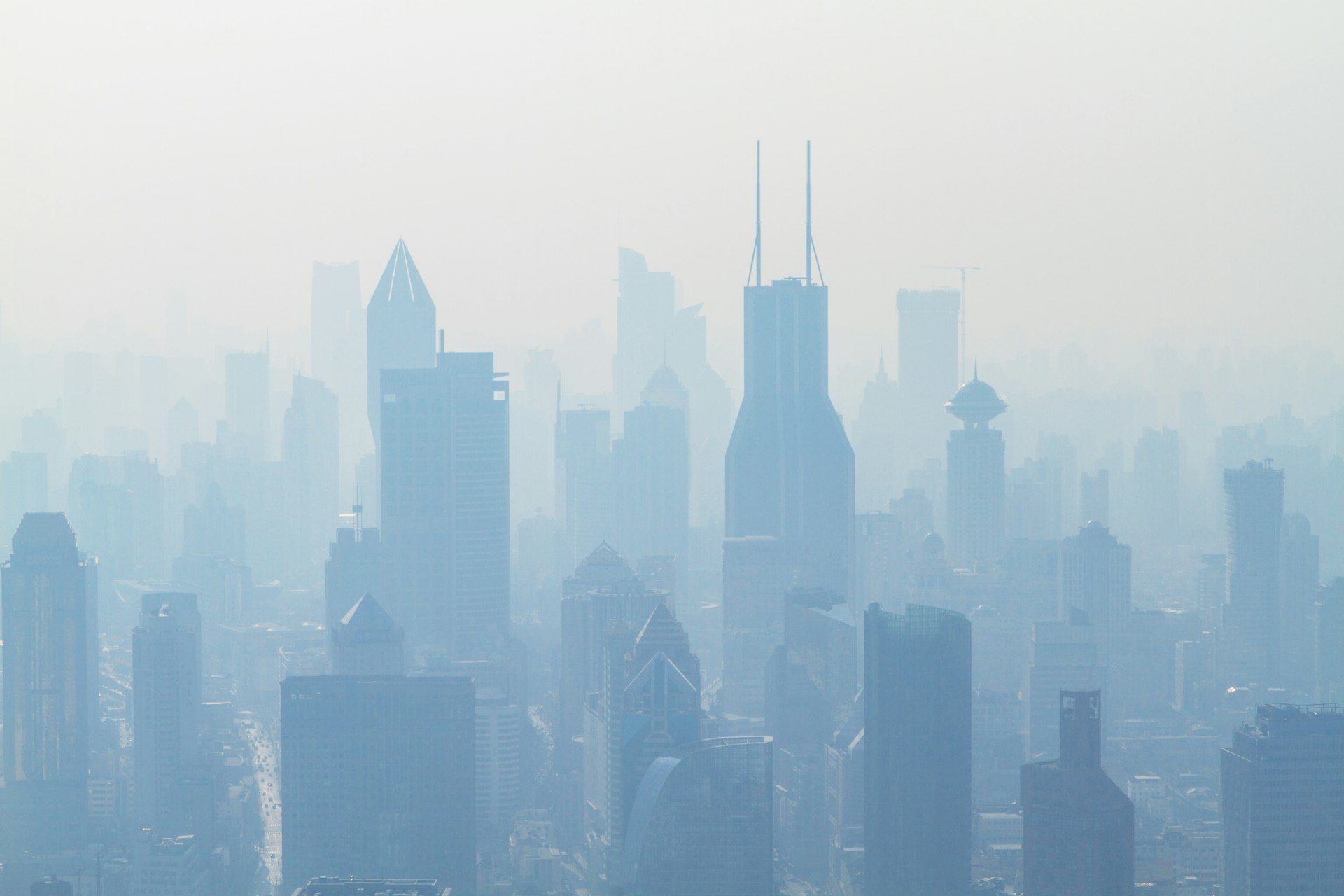Header: Air pollution in Shanghai, China.
Introduction
While recent scholarship has shed light on the variation in democracies' ability to solve environmental problems, relatively little attention has been given to autocracies, although they have often been assumed to perform worse in environmental protection than the average democracy. However, a cursory look at existing datasets suggests that both in Southeast-Asia as well as the Middle-East there are various cases of autocracies that perform surprisingly well on Yale's Environmental Performance Index (EPI).
Why do some autocracies do better in environmental protection than others, and what are the characteristics of these relatively successful regimes? Moreover, why do high-income autocracies perform relatively worse than their democratic high-income counterparts? In this cursory case study, I seek to shed light on these two questions.
What is Regime Type?
First, we have to define what regime type is. According to Schmitter and Karl (1991) regime type are the institutions that “determine the methods of access to the principal public offices; the characteristics of the actors admitted to or excluded from such access; the strategies that actors may use to gain access; and the rules that are followed in the making of publicly binding decisions.” In short, regime type determines what Dahl (1971) called the "rules of the game" within the state's borders.
Generally speaking, political scientists consider differences in regime type on a continuum consisting of degrees of democracy and autocracy, the former being identified by a system of high political participation and contestation and the latter less so.
According to the Varieties of Democracy Institute (V-Dem), autocracies are a proliferating regime type, making up 92 countries and 54% of the world’s population in 2019 (Lührmann et al. 2020). Therefore, understanding how these regimes are relating to environmental degradation is becoming increasingly important.
Lacking Literature
The theoretical and empirical literature on autocracies and environmental degradation is limited, however findings from other areas of study might provide some transferable theoretical implications. Similarly to studies on economic performance and war & peace (see for example Knutsen 2018 or Weeks 2012), we might expect the effect of autocratic institutions on environmental performance to vary widely. However, a visualization of the Environmental Protection Index (EPI) compared to the Polity IV Index measuring regime type offers some preliminary indications that there is less variation between autocracies than democracies (Marshall et al. 2014; Wendling et al. 2020). This seems to be in line with Povitkina's (2018) finding that democracies with high-levels of corruption and low quality of governance did not tend to perform better than the average autocracy (Fig. 1):

Selectorate theory, as purposed by Bueno de Mesquita et al. (2003), might provide a suitable theoretical starting-point for generating observable implications. The theory holds that the size of the state’s winning coalition (the people in power) might affect the regime’s willingness to provide public goods. The larger the winning coalition, the more constraints are put on the leadership, forcing them to deliver on public goods, not only private goods to the regime's insiders. Consequently, selectorate theory might imply that autocracies with relatively large winning coalitions (such as Singapore or the U.A.E.) would be more inclined to deliver on environmental performance than others. Miller (2014) and Geddes, Wright and Franz (2018) finds evidence for autocratic elections as a mechanism that offers the ruling party to aggregate information on public dissatisfaction to calibrate policy concessions. This may help strengthen the regime's legitimacy in the mid- to long term, albeit elections may be destabilizing in the short term (Knutsen, Nygård and Wig, 2017). In this regard, we might expect ruling authoritarian parties to adopt greener policies if subject to public dissatisfaction on environmental policy (such as pressure from activists or the opposition). Lastly, a recent study by Carlitz and Povitkina (2021) point to the influence of local business interest groups in authoritarian countries, and that local pro-environmental forces might face more difficulty changing policy in regimes that base their legitimacy on economic performance. In general, the way in which the regime's ruling party relates to different interest groups in society might also affect the outcome.
The Extreme Case of Singapore
"Extreme" cases are exemplified by their high residual value, being far from the mean of a given distribution; that is to say, they stand out (Seawright and Gerring 2008). Singapore fits the "extreme" case designation as it is an autocracy that is several standard deviations away from the mean autocracy in terms of environmental performance, scoring 58.1/100 on the 2020 EPI index. The benefit of extreme cases are that we can assume that it is their unique characteristics that may have caused their high residual value, making them suitable for an exploratory case study. Here, Singapore may shed light on the characteristics of autocracies that do particularly well in environmental protection. What could be the particular characteristics of Singapore that made it more inclined to deliver on environmental quality in comparison to other autocracies? Moreover, why does Singapore score relatively poorly seen in comparison to mid- to high-income democracy?

Large Winning Coalition
If we take Bueno de Mesquita et al.'s (2003) theory into consideration, then the size of Singapore's dominant political party may have implications for its incentives to deliver on public goods. Singapore's dominant political party, the People's Action Party (PAP), is indeed sizable, has a meritocratic selection system and an elaborate cadre system socializing its members. The total membership count and recruitment process of the PAP is politically guarded secret, but a 2014 estimate suggest that the PAP had about 15'000 members in 2006, making up 0.34% of the total Singaporean population (Tan 2014). The PAP has also encouraged some degree of democratization within the party ranks to encourage a more pluralistic policy-initiatives from different elements of the party. Singapore effectively works as a party-state, in which the the divisions between the PAP and the government has become increasingly illusive. With increasing diffusion of power across many stakeholders, PAP members may have genuine incentives to deliver on public goods, and hence also environmental performance.
Autocratic Elections
Seen in light of Miller (2014) and Knutsens, Nygård and Wig (2017), we may expect Singapore's ruling party to use autocratic elections to aggregate information about the populations policy-preferences and contribute to the legitimacy of its rule.
Singapore holds autocratic elections, in which the PAP gerrymanders the voting districts, giving Singapore one of the highest ”vote-to- seat”-disproportionalities in the world (Hin, 2020). Singaporean elections also lack independent oversight, as the Singaporean Elections Department is attached to the Prime Minister’s Office. There is room for some degree of contestation and participation, and Singapore does numerous opposition parties, yet their abilities to create political breakthroughs are highly limited.
According to the World Value Survey (WVS), environmental protection has grown to be come a more salient issue in Singapore following the 2010s. In 2020 60.8% of respondents felt that ”protecting the environment” was more important than ”economic growth and and job generation”, up form 43.3% in 2012, suggesting a change in public opinion. While environmental protection were not particularly prominent issues during Singapore's 2015 election, this has changed in the recent 2020 election, as reflected both in the election manifestos of PAP and Singapore's token opposition party - Worker's Party Singapore.

Interest Group System
Typically, the interest group systems in East-Asian states with a developmental legacy tend to have a corporatist outlook (Han, 2017). Singapore’s Minstry of Manpower (MoM) holds frequent and annualized conversations with Singapore’s largest labour union federation and employers federation - the National Trades Union Congress (NTUC) and the Singapore National Employers Federation (SNEF). The tripartite talks facilitates market-oriented goals, promoting ”harmonious labour-management relations [to] contribute to Singapore’s overall progress” (MoM, 2021). Comparatively, Singapore's environmental non-governmental organizations, do not enjoy the same kind of access to the policy-making process (Han, 2017).
According to Mock (2019), this tripartite relationship allows Singapore’s pro-business and pro-labour forces to influence environmental policy. This is particularly the case for Singapore’s petrochemical industry, whose growth has been encouraged by the parts of the PAP through the Singapore Economic Development Board (EDB). Singapore's petrochemical industry has grown to become one of country’s most profitable industries. Companies such as Mitsui, Solvay and the Petrochemical Corporation of Singapore support more than 25’000 high-paying jobs (per 2011) and earned over $81 billion Singapore dollar as of 2015, making Singapore the 7th largest petrochemical producer in the world (Mock 2019).

The impact of Singapore's market-oriented developmental goals, its corporatist outlook privileging business and labor interests as well as its sizable petrochemical industry all may challenge Singapore's ability to further improve its environmental quality vis-à-vis a comparative high-income democracy.
The Environmental Kuznets Curve (EKC)

Lastly, it is worth controlling for the degree of economic development (measured in GDP-per-capita). According to the environmental Kutzets curve hypothesis, we can expect to see an inverted U-shape relationship between environmental degredation and economic growth (see Fig. 2). According to Wendling et al. 2020, we do find a correlational relationship between environmental performance and GDP-per-capita. Yet, there is still much variation between the high-income autocracies such as Singapore, Saudi-Arabia and Qatar (see Fig. 3):

Conclusion and Discussion
This exploratory case study can offer some cursory indications for why some autocracies tend to do better than others in environmental performance. Singapore's large winning coalition, autocratic elections, corporatist interest group system and high economic development all may have affected its environmental performance. Below I have generated a set of hypotheses synthesized from previous literature and the above case study that can be further explored or tested in additional cases studies or large-N statistical studies:
H1: Autocracies with large winning coalitions have higher environmental performance than autocracies with smaller winning coalitions.
H2: Electoral autocracies with some degree of contestation have higher environmental performance than autocracies that do not.
H3: Autocracies with corporatist interest group systems and developmental goals privilege policy input from business- and labor interest groups above that of environmental interest groups, hampering environmental performance.
H4: High-income autocracies (measured in GDP-per-capita) have higher environmental performance than low-income autocracies.
Other aspects have not been included in this cursory exploration; for example, the role of economic externalities, the outsourcing of polluting industries or individual citizens carbon footprint all may affect the net environmental performance of the state. In this regard, there are also multiple opportunities to merge existing datasets to create compound indexes that control for the effect of certain variables (such as economic performance). Another worthwhile aspect to consider is the potential endogenous relationship between the politics within the state and that of international negotiations (over environmental agreements for example) that may affect the state’s environmental performance. These important variables may be included in a more comprehensive investigation.

